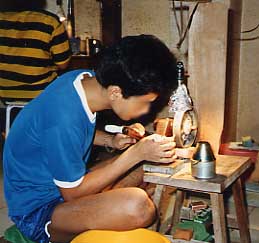
Lapidary is the practice of shaping stone, minerals, or gemstones into decorative items such as cabochons, engraved gems, and faceted designs. A person who practices lapidary is known as a lapidarist. A lapidarist uses the lapidary techniques of cutting, grinding, and polishing. Hardstone carving requires specialized carving techniques.

Mount Nebo is an elevated ridge located in Jordan, approximately 700 metres (2,300 ft) above sea level. Part of the Abarim mountain range, Mount Nebo is mentioned in the Bible as the place where Moses was granted a view of the Promised Land before his death. The view from the summit provides a panorama of the West Bank across the Jordan River valley. The city of Jericho is usually visible from the summit, as is Jerusalem on a very clear day. The biblical town of Nebo, now known as Khirbet al-Mukhayyat, is located 3.5 km away.

Relief is a sculptural method in which the sculpted pieces remain attached to a solid background of the same material. The term relief is from the Latin verb relevo, to raise. To create a sculpture in relief is to give the impression that the sculpted material has been raised above the background plane. When a relief is carved into a flat surface of stone or wood, the field is actually lowered, leaving the unsculpted areas seeming higher. The approach requires a lot of chiselling away of the background, which takes a long time. On the other hand, a relief saves forming the rear of a subject, and is less fragile and more securely fixed than a sculpture in the round, especially one of a standing figure where the ankles are a potential weak point, particularly in stone. In other materials such as metal, clay, plaster stucco, ceramics or papier-mâché the form can be simply added to or raised up from the background. Monumental bronze reliefs are made by casting.

Stone carving is an activity where pieces of rough natural stone are shaped by the controlled removal of stone. Owing to the permanence of the material, stone work has survived which was created during our prehistory or past time.

The Thinker is a bronze sculpture by Auguste Rodin, usually placed on a stone pedestal. The work depicts a nude male figure of heroic size sitting on a rock. He is seen leaning over, his right elbow placed on his left thigh, holding the weight of his chin on the back of his right hand. The pose is one of deep thought and contemplation, and the statue is often used as an image to represent philosophy.

Tomb KV17, located in Egypt's Valley of the Kings, is the tomb of Pharaoh Seti I of the Nineteenth Dynasty. It is also known by the names "Belzoni's tomb", "the Tomb of Apis", and "the Tomb of Psammis, son of Nechois". It is one of the most decorated tombs in the valley, and is one of the largest and deepest tombs in the Valley of the Kings. It was uncovered by Italian archaeologist and explorer Giovanni Battista Belzoni on 16 October 1817.

Pietra dura or pietre dure, called parchin kari or parchinkari in the Indian Subcontinent, is a term for the inlay technique of using cut and fitted, highly polished colored stones to create images. It is considered a decorative art. The stonework, after the work is assembled loosely, is glued stone-by-stone to a substrate after having previously been "sliced and cut in different shape sections; and then assembled together so precisely that the contact between each section was practically invisible". Stability was achieved by grooving the undersides of the stones so that they interlocked, rather like a jigsaw puzzle, with everything held tautly in place by an encircling 'frame'. Many different colored stones, particularly marbles, were used, along with semiprecious, and even precious stones. It first appeared in Rome in the 16th century, reaching its full maturity in Florence. Pietra dura items are generally crafted on green, white or black marble base stones. Typically, the resulting panel is completely flat, but some examples where the image is in low relief were made, taking the work more into the area of hardstone carving.
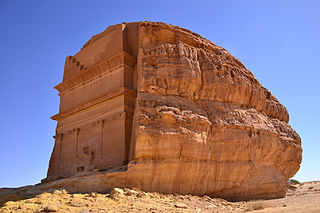
Hegra, known to Muslims as Al-Hijr, also known as Mada’in Salih, is an archaeological site located in the area of Al-'Ula within Medina Province in the Hejaz region, Saudi Arabia. A majority of the remains date from the Nabataean Kingdom. The site constitutes the kingdom's southernmost and second largest city after Petra, its capital city. Traces of Lihyanite and Roman occupation before and after the Nabatean rule, respectively, can also be found.
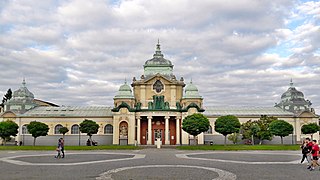
The Lapidarium is a lapidarium and a part of the National Museum in Prague, Czech Republic. It is the largest permanent exhibition of historical collections of stone sculpture, tombs and architectonical fragments originating from Bohemia, mostly from Prague.

Hardstone carving, in art history and archaeology, is the artistic carving of semi-precious stones, such as jade, rock crystal, agate, onyx, jasper, serpentinite, or carnelian, and for objects made in this way. Normally the objects are small, and the category overlaps with both jewellery and sculpture. Hardstone carving is sometimes referred to by the Italian term pietre dure; however, pietra dura is the common term used for stone inlay work, which causes some confusion.

Kosovo Museum is the national museum of Kosovo, located in the city of Pristina. Established by Yugoslav authorities in 1949, this is the largest museum in Kosovo. It is situated in a 1889 Austro-Hungarian-style building, formerly used as the high military command headquarters.

The Lapidarium is a lapidarium (museum) in Kerch, Crimea. It has a collection of samples of ancient art, containing items found during the excavation of the ancient Bosporan kingdom and other finds discovered on the territory of the Kerch peninsula. It occupies one of leading places among the repositories of classical epigraphic monuments in the world. Lapidarium are stored in the Kerch Bosporan Greek inscriptions made in stone, sculpture and architectural details, samples, gebraistskih and Turkish gravestones.

The statues of Madonna, Saint Dominic and Thomas Aquinas are outdoor sculptures by Matěj Václav Jäckel, installed on the north side of the Charles Bridge in Prague, Czech Republic. Later, these statues were moved to the Lapidarium of the National Museum of the Czech Republic.

Aequum Tuticum was a Roman vicus in southern Italy, about 35 km east-northeast of Beneventum. The site lies beside Saint Eleuterio hamlet, overlooking Miscano Valley at an elevation of 575 m, about 15 km north of the modern Ariano Irpino, within Irpinia historical district. The vicus name is partly Latin and partly Oscan.
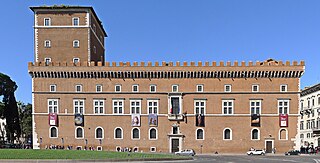
The Museo Nazionale del Palazzo di Venezia is a state museum in Rome (Italy), housed in the palace of the same name together with the important Library of Archaeology and Art History.
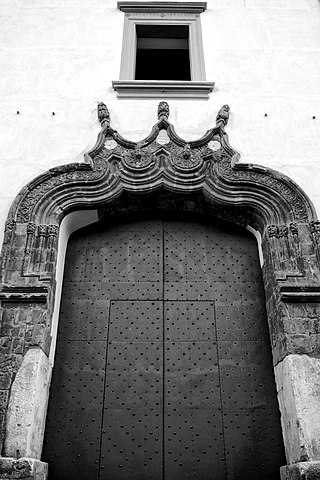
The Museo Provinciale Campano di Capua is a provincial museum located in Capua, southern Italy. Established in 1870 and inaugurated in 1874, it is housed in the historic Palazzo Antignano. The museum is dedicated to ancient Italian civilization in Campania, and is home to an extensive collection of ritual statues representing matres matutae coming from the ancient Roman site of Capua antica. It also hosts the second largest lapidarium in the region, after that of the National Archaeological Museum of Naples.

The Estense Lapidary Museum is a lapidarium-museum in Modena, Italy, located around the interior quadrangle of the Palazzo dei Musei's ground floor. It is owned by the province of Modena and the Gallerie Estensi. As the first public museum to be commissioned by the Duke Francesco IV d'Este upon his re-entry into Modena in 1814, it stands as a symbol of the collaboration between church, state and nobility. It also marks a new direction for the city of Modena, one recognising its rich historical identity.
A lapidarium is a place where stone monuments and fragments of archaeological interest are exhibited.

The Stobi railway station is located on railway corridor 10, near the ancient archeological site of Stobi, in the southern part of North Macedonia.
The Lizzadro Museum of Lapidary Art is a museum dedicated to the lapidary arts with displays of gemstones, jewelry and bejeweled objects, and exhibits on earth science. The museum was founded in Elmhurst, Illinois, United States, in 1962, but moved to Oak Brook, Illinois in 2019.



















